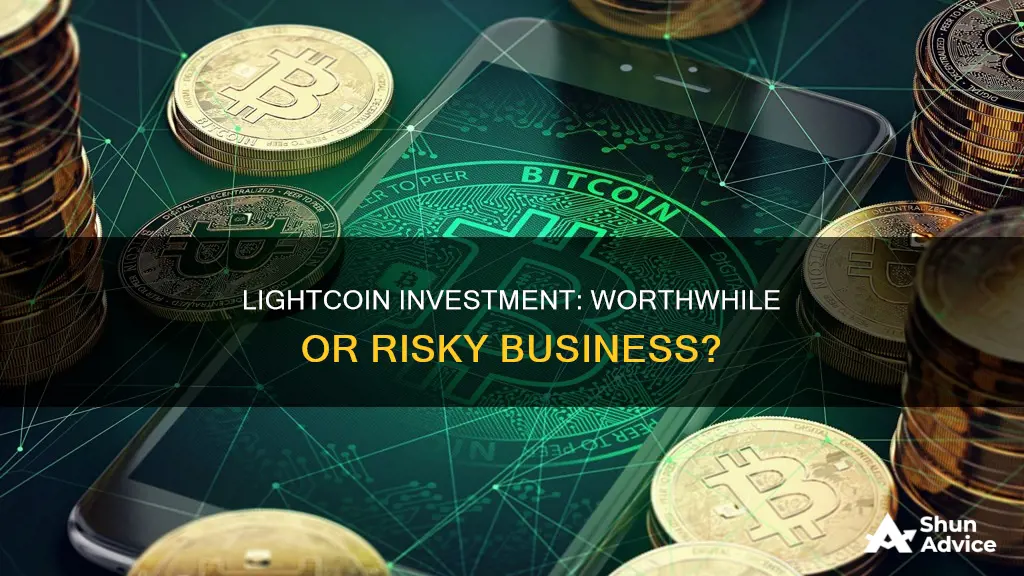
Cryptocurrencies have become increasingly popular among investors worldwide. They are digital currencies that use cryptographic systems to secure transactions and are often decentralised, making them immune to government interventions. Bitcoin, the world's oldest cryptocurrency, has been the subject of various price predictions, with some speculating that it could reach $1.48 million by 2030. However, investing in Bitcoin and other cryptocurrencies carries risks, including volatility, energy consumption, and potential regulatory issues. This article will explore the advantages and disadvantages of investing in Lightcoin and whether it is a good investment option.
What You'll Learn

Volatility
The cryptocurrency market is extremely volatile. Litecoin, in particular, has experienced dramatic price fluctuations over the years. For example, in 2017, Litecoin's price climbed more than 12,000% to over $360 at its all-time high, before falling 94% to $20 in 2018.
Litecoin's price history demonstrates the inherent volatility of the asset. While it has shown strong potential with periods of upward trends, it has also experienced significant declines. In 2024, Litecoin's price has ranged from a high of around $87 to a low of approximately $60, with a current price of about $72.
The volatile nature of Litecoin and other cryptocurrencies is driven by speculation. Crypto investors bet on the price movements of these assets, causing sudden increases or decreases in value. Additionally, market sentiment, news, and economic factors can influence volatility.
When considering investing in volatile assets like Litecoin, it is essential to be cautious and aware of the risks involved. The potential for substantial gains coexists with the possibility of significant losses.
Bitcoin Vault: A Smart Investment Decision?
You may want to see also

Efficiency as a means of payment
Litecoin is often referred to as "digital silver" to Bitcoin's "digital gold". It was created in 2011 by former Google employee Charlie Lee and is based on the Bitcoin protocol code, but with a faster blockchain and lower reward per block.
Litecoin has a faster transaction processing time than Bitcoin, with a block generation time of 2.5 minutes, compared to Bitcoin's 10 minutes. It also has a lower transaction fee, which is around $0.01. These factors, along with its fixed supply and halving mechanism, make it an attractive option for investors.
The efficiency of Litecoin as a means of payment is one of its key advantages. Its faster block generation time means that transactions are processed more quickly, and its lower transaction fees make it a more cost-effective option for sending and receiving money.
In addition, Litecoin has a larger supply of coins available, with a maximum supply of 84 million LTC compared to Bitcoin's 21 million BTC. This makes it more accessible to a wider range of users and helps to facilitate its use as a medium for daily transactions.
The use of the Scrypt hashing algorithm also contributes to the efficiency of Litecoin as a means of payment. This algorithm requires more memory than processing power, making it more difficult for large-scale mining firms to gain an advantage. As a result, Litecoin is more decentralized and accessible to individual miners.
Overall, the efficiency of Litecoin as a means of payment is a key factor in its potential as a long-term investment. Its faster transaction speeds, lower fees, and greater accessibility make it a more user-friendly option for those looking to adopt cryptocurrency as a payment method.
The Wild Ride of Investing in Bitcoin
You may want to see also

Environmental concerns
The process of mining cryptocurrencies has been found to have a detrimental impact on the environment. Mining for Bitcoin, for instance, is particularly energy-intensive due to the complex mathematical calculations required to create new coins. The energy consumption of the cryptocurrency industry as a whole is comparable to that of a small country. China, a major player in Bitcoin mining, relies heavily on coal to power its operations, contributing to air pollution and climate change.
Litecoin, like Bitcoin, uses a "proof-of-work" scheme, which requires increasing computing power and energy use over time. This leads to a negative net social benefit as the energy requirements to produce a single coin become increasingly high. The environmental impact of Litecoin and other cryptocurrencies is a growing concern for investors, who are seeking more eco-friendly alternatives.
Some cryptocurrencies are making efforts to reduce their environmental footprint. For example, Chia and IOTA use alternative methods that require less processing power and energy consumption. Nano, another digital currency, employs a lightweight consensus protocol that promises minimal energy use and maximum efficiency.
The inefficiency and waste generated by cryptocurrency mining are particularly notable when compared to existing financial infrastructure. The CO2 produced by a single Bitcoin transaction is equivalent to that produced by 722,705 Visa card transactions.
While some argue that cryptocurrencies use renewable energy and incentivize the development of greener energy production, the reality is more complex. Although a significant portion of Bitcoin mining may be powered by renewables, the concentration of mining operations in China means that a large proportion of energy still comes from burning coal.
The high energy consumption and associated environmental impacts of cryptocurrencies like Litecoin present a challenge to the goal of creating a more sustainable future. As awareness of these issues grows, developers are turning their attention to creating more eco-friendly digital currencies and mining practices.
Litecoin Investment Safety: Is It a Secure Bet?
You may want to see also

Use by criminals
Litecoin is a cryptocurrency created in 2011 by Charlie Lee, a former Google engineer. It is based on the Bitcoin protocol code but features a faster blockchain and lower reward per block. Litecoin is often compared to Bitcoin, with the former being referred to as the "silver to Bitcoin's gold".
The use of cryptocurrency in criminal schemes is growing, and criminals' use of cryptocurrencies has become more sophisticated. Cryptocurrencies are increasingly being used by criminals as a means of payment or investment fraud currency, as well as to obfuscate money flows as part of complex money laundering schemes.
Criminals are using privacy wallets, which make it harder to track cryptocurrency transactions. In 2020, at least 13% of all criminal proceeds in Bitcoin passed through privacy wallets, up from 2% in 2019, according to a study by Elliptic, a digital currency forensics firm. Privacy wallets combine, mix and anonymise cryptocurrency transactions, making it complicated to follow a money trail.
Decentralised exchanges, which are not run by a specific company, are also used to launder funds.
While the total volume of illicit activity in crypto assets has grown in absolute terms over the years, it accounts for less than 1% of all digital transactions, down from 35% in 2012, according to Elliptic.
Litecoin has been used in criminal activities, including the hack of famous Twitter users' accounts in July 2020, where much of the $120,000 in Bitcoin raised went through a privacy wallet. Additionally, part of the $280 million in crypto assets stolen from the Asian exchange KuCoin in September 2020 also went through a privacy wallet.
Bitcoin's Decade: A Look Back at Early Investors
You may want to see also

Real value
Litecoin is often referred to as the "silver" of the crypto world, with Bitcoin being the "gold". It is one of the oldest cryptocurrencies and has been active for over a decade. It is currently ranked among the top 20 coins by market cap, and has been in the top 10 in the past.
Litecoin has a lot of similarities with Bitcoin, but it is cheaper and faster, making it a popular choice for investors. It has a fixed supply, like Bitcoin, but has four times the supply, with a maximum supply of 84 million LTC. It also has a faster block generation time, at 2.5 minutes compared to Bitcoin's 10 minutes. This makes it a faster solution for sending and receiving, and it also offers cheaper transactions.
Litecoin has been through several bear markets and survived, and it has a strong, established community. It has also been used for actual purchases, especially in South America, and is accepted by many vendors. It has a solid technical foundation, and has been described as reliable and safe.
However, Litecoin has been described as lacking a strong brand, and it doesn't have much to offer besides being a store of value. It has also been criticised for being highly centralised, and its price is dependent on the behaviour of its creator, Charlie Lee.
Litecoin has been through a period of underperformance, and its halving events have not delivered the price gains that were expected. However, it has been adopted by institutional investors as one of the four "safe" cryptocurrencies. Its price is also expected to rise in the coming years, with some experts predicting it will reach $1,000, and others saying it will be worth more than it is now.
Overall, Litecoin is a good long-term investment with a bright future as a classic and reliable altcoin. It is an established top 20 coin with a lot of potential, and it is similar to Bitcoin but cheaper and faster.
Is Bitcoin Mining a Profitable Investment Now?
You may want to see also
Frequently asked questions
Like any investment, there are risks involved when investing in Litecoin. Cryptocurrencies are highly volatile and susceptible to market manipulation. They are also not insured by the Federal Deposit Insurance Corporation or the Securities Investor Protection Corporation. However, Litecoin has advantages such as being decentralized, having cheaper and faster money transfers, and being a pseudonymous form of transaction.
There are several risks to consider when investing in Litecoin, including user risk, regulatory risks, counterparty risks, management risks, programming risks, and market manipulation. User risk refers to the inability to reverse or cancel a transaction once it has been sent. Regulatory risks refer to the unclear status of cryptocurrencies in many areas, which could lead to a sudden crackdown or price drop. Counterparty risks involve the possibility of theft or loss by exchanges or other custodians storing your cryptocurrency. Management risks arise from the lack of coherent regulations, resulting in few protections against deceptive management practices. Programming risks are associated with smart contracts used by investment and lending platforms, which may contain bugs or exploits that lead to investment losses. Lastly, market manipulation remains a significant problem in the cryptocurrency space, with influential entities acting unethically.
Litecoin offers several advantages, including faster and cheaper money transfers due to its decentralized nature. It eliminates the need for trusted third parties like banks, making transactions more efficient and secure. Litecoin also provides pseudonymity, allowing users to maintain a degree of privacy. Additionally, Litecoin has a limited supply of 21 million coins, which can make it a hedge against inflation.







